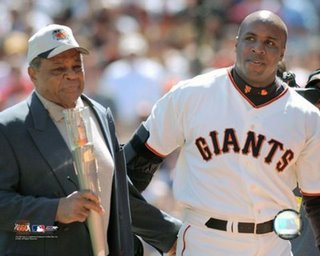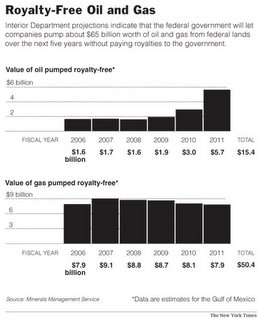Gold Belly for Family Foods
Just logistics and packaging.
Instgruct what should be frozen and for how long.
Promote and sell 3rd party food
One man pontificates on issues great and small. OK, mostly small and petty.



BlackBerry maker Research in Motion agreed to pay $612.5 million to patent holding company NTP to settle a long-running dispute that had threatened to shut down the popular wireless e-mail service for its 3 million users.
3 million is a lot of users, but the amount of press this has gotten is nuts.



Harry Whittington is the first person Chaney ever shot by accident.
The Daily Show suggested that Chaney didn't take a hunting safety course because he received a series of deferrments.
Anyway calling the activity in question "hunting" is a bit of a stretch.
In 2003 Chaney when pheasant killing in Pennsylvania, but he didn't have to waste time hunting downt he little fellas. Upon his arrival gamekeepers released 500 pen-raised pheasants from nets for the benefit of him and his party, of which at least 417 where killed. Cheney chalked up about 70 of the birds.
Sporty!


 An orthodox rabbi walks into a bar is in full regalia. Black coat, black hat, beard.
An orthodox rabbi walks into a bar is in full regalia. Black coat, black hat, beard.



| Income Group | Pretax Income | Average Tax Receipts | As % of Income |
| Bottom 20% | $7,946 | $1,449 | 18.2% |
| Second 20% | $20,319 | $2,847 | 14.0% |
| Middle 20% | $35,536 | $5,622 | 15.8% |
| Fourth 20% | $56,891 | $9,835 | 17.3% |
| Top 20% | $116,666 | $21,623 | 18.5% |

This is a partial list of some of my random interests.
| Item | Why |
| Title 9 | Huge cultural change in gender relations |
| Containerized Cargo | Transforming world economy 20’ at a time |
| Liberty Ships | Won WW2 but no one knows |
| Language Issues | Read McWhortor |
| Game Theory | See related post |
| Why some countries work and why others don’t | answer: corruption |
| Things people believe that aren't true (sugar rush, the cold gives you a cold) | Because a glass of punch doesn’t hurt |
| Dot com survivors | It would help to understand what worked |
| Book called Flux | Women with choices making them. Why? |
| Mormonism | The American religion. Amazing history. |
| Radicalization | Why people decide its ok to do extreme things |
| Moon Illusion | Big on the horizon. Small at the zenith. Why? |
| Prosecutorial mindset | OK, I watch too much Law and Order |
| Things that are better | Why dwell on just the negative? (weather forecasting, economic controls, food costs, race relations, women’s rights, car safety) |
After two bellyflops, Congress is considering a dollar coin again. This time it might actually work. http://money.cnn.com/2005/04/27/pf/new_dollar/
Why the push for dollar coins? The nominal argument is that it would save the Mint a mint. Paper money doesn't last long. Coins do. Believe it or not, the savings add up to billions over the long hall.
In this new push, however, the motivation is the seigniorage. That delectable word refers to the difference between the cost of producing a coin (or stamp) and its face value (its selling price.) Seigniorage happens when money is lost or put into collections.
Consider the very successful State's Quarters program. It costs the Mint less than five cents for each 25-cent piece it produces. The government makes money whenever someone "buys" a coin then chooses not to spend it. The Treasury estimates that it has earned about $5 billion in seigniorage profits from the quarters so far.
So the new dollar coins are an attempt to cash in on this phenomon.
But this begs a larger question about our currency. Why are we using the 4 coins and 6 bills currently in widespread distriubtion (if you include the $50 bill?)
The last time we kicked out a coin for being too "cheap" was the half cent which was retired in 1857. Note, the actual story of retired coins is a bit more complicated.
So, for almost 150 years a penny has been the smallest denominated coin. In that time a penny has lost 95% of its value. That is, what cost 1 cent in 1857 now costs 20.5 cents. A dime back then bought what $2.05 buys now.
Here is the cost of each coin, the seigniorage for each, and the margin the Mint makes on each.
| Coin | Cost | Face | Seigniorage | Margin |
| Dollar | 10 | 100 | 90 | 900.00% |
| Quarter | 4.25 | 25 | 20.75 | 488.24% |
| Dime | 1.9 | 10 | 8.1 | 426.32% |
| Nickel | 3.1 | 5 | 1.9 | 61.29% |
| Penny | 0.8 | 1 | 0.2 | 25% |
The conclusion is obvious. Lose the nickel and penny. Make the dime the smallest value coin, which is worth almost exactly what the half penny was worth when it was phased out.
Some years ago a smart casino owner added a “tracking board” to roulette wheels. This shows the numbers that most recently “hit.” When red came up several times in a row, players increased their betting on black. After all, red can’t keep coming up. Apparently no indictments were brought down for violating the law of independent trials which says that previous spins of the wheel have absolutely no impact on future outcomes. For an interesting take on trying to win against roulette see this book: http://tinyurl.com/a9nbj
Why are we so influenced by a previous result that has no predictive value?
It seems that human beings have a deep need to search out patterns and assign causality to random events.
I wonder if this isn’t hardwired into our neurology. One of the things that living things are really good at is pattern recognition. Arguably it is our advanced pattern recognition abilities that define “humanness.” We make our way through life by identifying patterns and acting on those insights. Perhaps it’s not a surprise that we go overboard and find relationships where none actually exist.